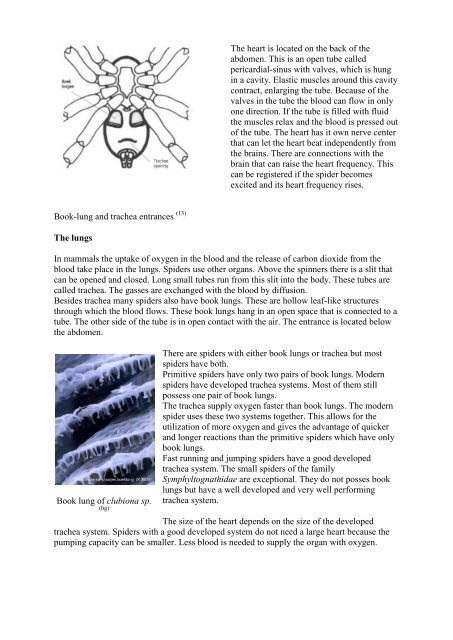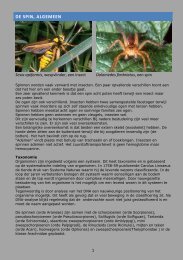The spider.pdf - Spiders from Europe, Australia and some immunology
The spider.pdf - Spiders from Europe, Australia and some immunology
The spider.pdf - Spiders from Europe, Australia and some immunology
You also want an ePaper? Increase the reach of your titles
YUMPU automatically turns print PDFs into web optimized ePapers that Google loves.
<strong>The</strong> heart is located on the back of the<br />
abdomen. This is an open tube called<br />
pericardial-sinus with valves, which is hung<br />
in a cavity. Elastic muscles around this cavity<br />
contract, enlarging the tube. Because of the<br />
valves in the tube the blood can flow in only<br />
one direction. If the tube is filled with fluid<br />
the muscles relax <strong>and</strong> the blood is pressed out<br />
of the tube. <strong>The</strong> heart has it own nerve center<br />
that can let the heart beat independently <strong>from</strong><br />
the brains. <strong>The</strong>re are connections with the<br />
brain that can raise the heart frequency. This<br />
can be registered if the <strong>spider</strong> becomes<br />
excited <strong>and</strong> its heart frequency rises.<br />
Book-lung <strong>and</strong> trachea entrances (13)<br />
<strong>The</strong> lungs<br />
In mammals the uptake of oxygen in the blood <strong>and</strong> the release of carbon dioxide <strong>from</strong> the<br />
blood take place in the lungs. <strong>Spiders</strong> use other organs. Above the spinners there is a slit that<br />
can be opened <strong>and</strong> closed. Long small tubes run <strong>from</strong> this slit into the body. <strong>The</strong>se tubes are<br />
called trachea. <strong>The</strong> gasses are exchanged with the blood by diffusion.<br />
Besides trachea many <strong>spider</strong>s also have book lungs. <strong>The</strong>se are hollow leaf-like structures<br />
through which the blood flows. <strong>The</strong>se book lungs hang in an open space that is connected to a<br />
tube. <strong>The</strong> other side of the tube is in open contact with the air. <strong>The</strong> entrance is located below<br />
the abdomen.<br />
Book lung of clubiona sp.<br />
(bg)<br />
<strong>The</strong>re are <strong>spider</strong>s with either book lungs or trachea but most<br />
<strong>spider</strong>s have both.<br />
Primitive <strong>spider</strong>s have only two pairs of book lungs. Modern<br />
<strong>spider</strong>s have developed trachea systems. Most of them still<br />
possess one pair of book lungs.<br />
<strong>The</strong> trachea supply oxygen faster than book lungs. <strong>The</strong> modern<br />
<strong>spider</strong> uses these two systems together. This allows for the<br />
utilization of more oxygen <strong>and</strong> gives the advantage of quicker<br />
<strong>and</strong> longer reactions than the primitive <strong>spider</strong>s which have only<br />
book lungs.<br />
Fast running <strong>and</strong> jumping <strong>spider</strong>s have a good developed<br />
trachea system. <strong>The</strong> small <strong>spider</strong>s of the family<br />
Symphyltognathidae are exceptional. <strong>The</strong>y do not posses book<br />
lungs but have a well developed <strong>and</strong> very well performing<br />
trachea system.<br />
<strong>The</strong> size of the heart depends on the size of the developed<br />
trachea system. <strong>Spiders</strong> with a good developed system do not need a large heart because the<br />
pumping capacity can be smaller. Less blood is needed to supply the organ with oxygen.



